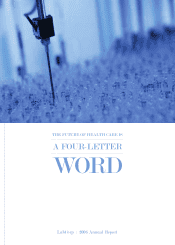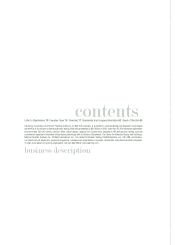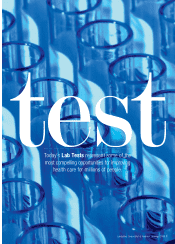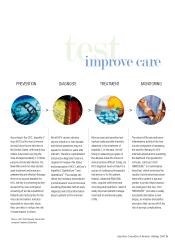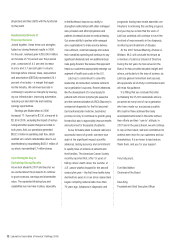LabCorp 2006 Annual Report Download - page 7
Download and view the complete annual report
Please find page 7 of the 2006 LabCorp annual report below. You can navigate through the pages in the report by either clicking on the pages listed below, or by using the keyword search tool below to find specific information within the annual report.
................................>..............................>.............................>.............................
PREVENTION
According to the CDC, hepatitis C
virus (HCV) is the most common
chronic blood-borne infection in
the United States, with nearly four
million Americans carrying the
virus and approximately 2.7 million
persons chronically infected. Yet,
fewer than one in ten virus carriers
seek treatment and many are
unaware they are infected. Because
there is no vaccine available for
HCV, the key to preventing further
spread of the virus is targeted
screening of at-risk populations.*
Patients who test positive for the
virus can be treated, and also
educated on important steps
they can take to reduce the risk
of transmission to others.
* Source: CDC 2006 Sexually Transmitted
Diseases Treatment Guidelines
Not all HCV carriers develop
chronic infection or liver disease,
and clinical symptoms may not
appear for months or years after
infection. Therefore, sophisticated
and precise diagnostic tools are
required to measure the status
and progression of HCV. LabCorp’s
hepatitis C QuantaSure™ and
QuantaSure™ Plus assays can
detect and measure extraordinari-
ly small levels of virus in the blood,
providing physicians with an early
diagnosis and critical information
about a patient’s HCV viral load.
More precise and sensitive test-
ing has made possible dramatic
advances in the treatment of
hepatitis C. In the past, the dif-
ficulty in assessing progress of
the disease made the choice of
clinical options difficult. Today, an
HCV diagnosis need not lead to a
course of continuous therapeutic
trial and error for the patient.
Instead, advanced RNA/DNA
tests, coupled with better and
more targeted treatment, result in
vastly improved patient manage-
ment and an enhanced quality
of life.
The extent of fibrosis and necro-
inflammatory activity in the liver
is a key component of assessing
the need for therapy for HCV-
infected patients and of predicting
the likelihood of progression to
cirrhosis. LabCorp’s HCV
FIBROSURE™ is a noninvasive
blood test, which combines the
results of six biochemical serum
tests with a patient’s age and
gender to predict these destruc-
tive changes in the liver. HCV
FIBROSURE™ provides a readily
accessible alternative to liver
biopsy, an invasive and painful
procedure that carries with it the
risk of serious complications.
test
improve care
DIAGNOSIS TREATMENT MONITORING
.....................................
Laboratory Corporation of America® Holdings 2006 5
.....................................
.....................................

